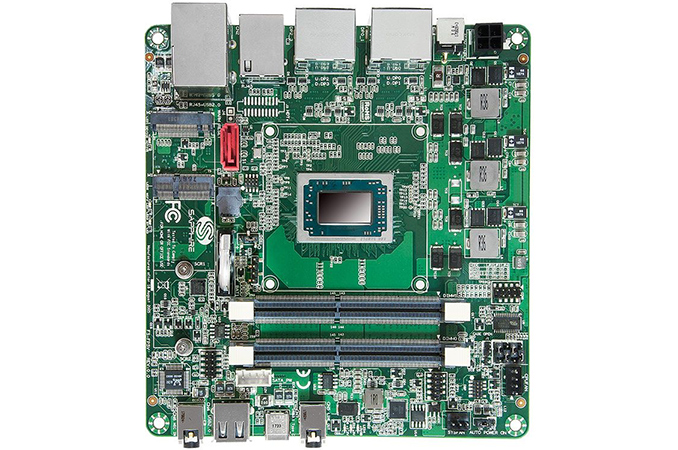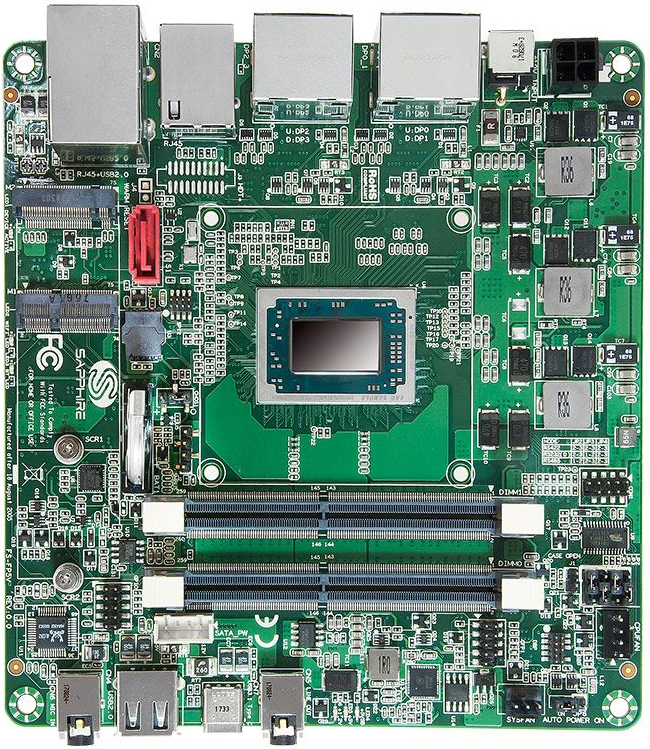Sapphire Unveils FS-FP5V: AMD Ryzen Embedded Mini-STX Motherboard
by Anton Shilov on July 9, 2018 10:00 AM EST- Posted in
- Motherboards
- AMD
- Sapphire
- Ryzen Embedded
- FP5V

Sapphire has announced one of the world’s first platforms based on AMD’s Ryzen Embedded V1000-series APUs. The motherboard is aimed at various embedded applications that can take advantage of AMD’s latest Zen and Vega architectures and their capabilities. The FS-FP5V also happens to be the industry’s first Mini-STX motherboards to feature AMD’s processor.
The Sapphire FP5V is based on AMD’s Ryzen Embedded V1000 APU featuring two or four cores with SMT clocked at 2 – 3.35 GHz base frequency, AMD’s Radeon Vega 3/8/11 iGPU, a dual-channel memory controller, and so on. Depending on requirements for performance and price, the Ryzen Embedded SoCs can feature a 12 – 25 or a 35 – 54 W TDP. AMD introduced its Ryzen Embedded chips earlier this year and will continue to sell them throughout 2028, giving adopters plenty of time to build and sell their products.
The motherboard is outfitted with two DDR4 SO-DIMMs supporting up to 32 GB of DDR4-2400 – DDR4-3200 memory, a SATA connector, an M.2-2280 slot (PCIe 3.0 x4 or SATA) for SSD, an M.2-2242 slot for a Wi-Fi module, two GbE ports (enabled by Realtek’s RTL8111G controllers), a quad-channel audio controller (ALC262), three USB 2.0 headers, one USB 3.1 Type-C connector, one RS232/422/485 module, etc. See precise specs in the table below.
The key features of Sapphire’s FP5V are of course up to four high-performance Ryzen CPU cores, AMD’s Radeon Vega iGPU with up to 704 stream processors as well as rich connectivity capabilities (e.g., four display outputs). The list of embedded applications that may require such embedded SoCs. include various gaming machines, digital signage, thin clients, medical imaging, and so on.
Sapphire’s FP5V is available for order from the company’s web site. Pricing depends on exact configurations as well as volumes.
| Sapphire's Mini-STX Motherboard with Ryzen Embedded V1000 APUs | ||
| FP5V | ||
| APU (Soldered Down) |
Ryzen Embedded V1202B: 2C/4T, 2 - 3.6 GHz, Vega 3, 12 - 25W Ryzen Embedded V1605B: 4C/8T, 2.06 - 3.6 GHz, Vega 8, 12 - 25W Ryzen Embedded V1756B: 4C/8T, 3.25 - 3.6 GHz, Vega 8, 35 - 54W Ryzen Embedded V1807B: 4C/8T, 3.35 - 3.8 GHz, Vega 11, 35 - 54W |
|
| Graphics | Ryzen Embedded V1202B: Radeon Vega 3 with 192 SPs at 1100 MHz Ryzen Embedded V1605B: Radeon Vega 8 with 512 SPs at 1100 MHz Ryzen Embedded V1756B: Radeon Vega 8 with 512 SPs at 1100 MHz Ryzen Embedded V1807B: Radeon Vega 11 with 704 SPs at 1300 MHz |
|
| Display Outputs | 4 × DisplayPort 1.4 | |
| Memory | 2 × DDR4 SO-DIMM slots for up to 32 GB of DDR4 SDRAM Ryzen Embedded V1202B: up to DDR4-2400 Ryzen Embedded V1605B: up to DDR4-2400 Ryzen Embedded V1756B: up to DDR4-3200 Ryzen Embedded V1807B: up to DDR4-3200 |
|
| Ethernet | 2 × Realtek RTL8111G controllers | |
| Storage | 1 × SATA 6 Gbps 1 × M.2 (PCIe 3.0 x4 or SATA) |
|
| Audio | Realtek ALC262 4-channel audio |
|
| USB | 4 × USB 2.0 Type-A 1 × USB 3.1 Type-C |
|
| Serial Port | 1 × RS232/422/485 header | |
| Wi-Fi | M.2-2242 slot | |
| Operating Temperature | 0°C~50°C (32°F~122°F) | |
| Form-Factor | Mini-STX (147.3 mm × 139.7 mm | 5.8" × 5.5") | |
Related Reading:
- ASRock at CES 2018: Micro-STX DeskMini GTX PC Gets Coffee Lake
- SilverStone Introduces VT01 Mini-STX Chassis for $35
- ASRock DeskMini 110 mini-STX PC Review
- MSI Cubi 2 Plus vPro Skylake mini-STX PC Review
- ECS LIVA One Skylake mini-PC Review
Source: Sapphire (via Tom’s Hardware)













28 Comments
View All Comments
ERJ - Monday, July 9, 2018 - link
Too bad they are using Realtek ethernet. If they used Intel it would make for a great little firewall or even small lab VM server.jordanclock - Monday, July 9, 2018 - link
What's wrong with Realtek for those purposes?ERJ - Monday, July 9, 2018 - link
They tend to be a bit unstable, if not outright unsupported, in several of the major distributions. VMware has been dropping support for them in newer versions and pfSense recommends against them.ky41083 - Monday, July 9, 2018 - link
Because FreeBSD's Realtek NIC drivers are pretty awful. So anything FreeBSD based, isn't going to work well, network wise. Linux and even Windows have much better Realtek NIC drivers. Windows just works, in Linux you can get away with turning off a few offloading features.Samus - Monday, July 9, 2018 - link
Considering Realtek has more marketshare in integration than every other manufacture combined, if anyone is dropping support for them, their priorities are wrong. That isn't Realtek's fault. That isn't even Realtek's problem; they seem to be doing just fine without these niche software vendors flailing support.jospoortvliet - Tuesday, July 10, 2018 - link
One generally picks a software platform first I am afraid, based on in-house expertise and such... Linux might indeed be by far the dominant player in this market but freebsd and its derivatives are not irrelevant. realtek should think twice before allowing others to come in and do better... because that is what happens if you screw up for too long.eastcoast_pete - Saturday, July 14, 2018 - link
Full disclaimer: I am not an expert on Linux, having mostly stayed with Windows and Apple. However, as I understand it, the responsibility for the absence of good Linux or freeBSD drivers for Realtek NICs probably lies with - Realtek. If a hardware manufacturer wants to make sure that their kit is well-supported by Linux or freeBSD, they contribute to the next distro by writing and submitting the drivers in question. Intel does it, AMD does it, NVIDIA does it, ARM does it etc. I think it's a case of Realtek figuring they don't need that market, and it's not worth their effort. If that's correct, than the selection of Realtek's NICs for these is a shame, as it will limit their use.sor - Monday, July 9, 2018 - link
I’ve been waiting what seems to be an eternity for the 2400G based ZBOX MA551 that was shown in 2017. Maybe this V1807B would fit the bill.watlina - Monday, July 9, 2018 - link
Very Similar to the UDOO Bolthttps://www.kickstarter.com/projects/udoo/udoo-bol...
ayqazi - Monday, July 9, 2018 - link
Except no Arduino-like functionality